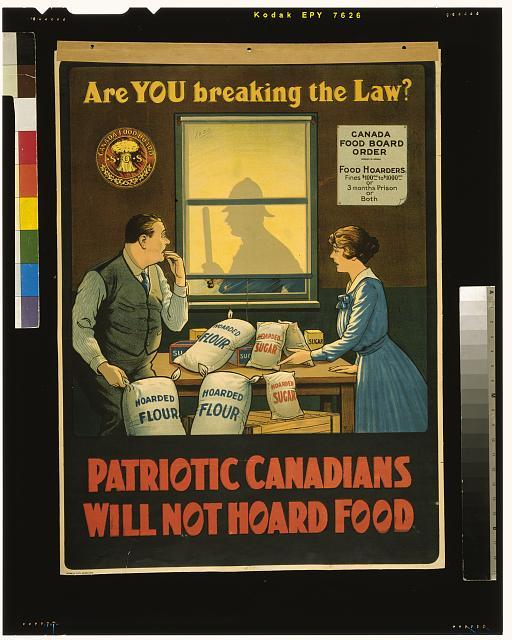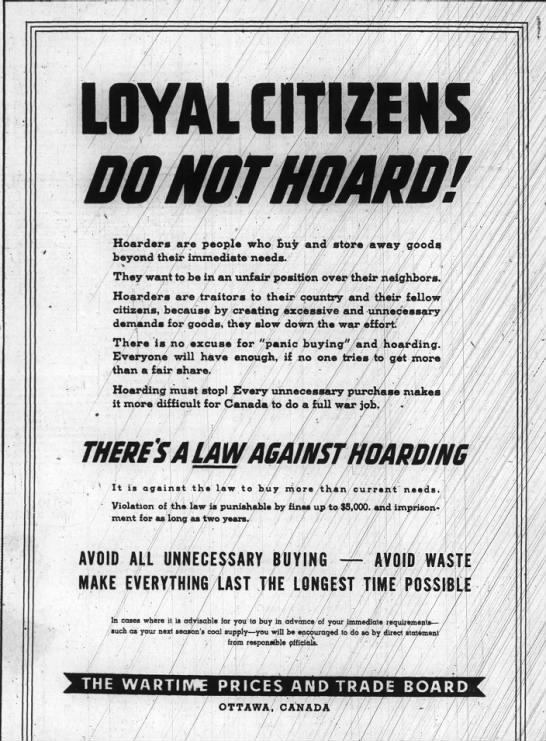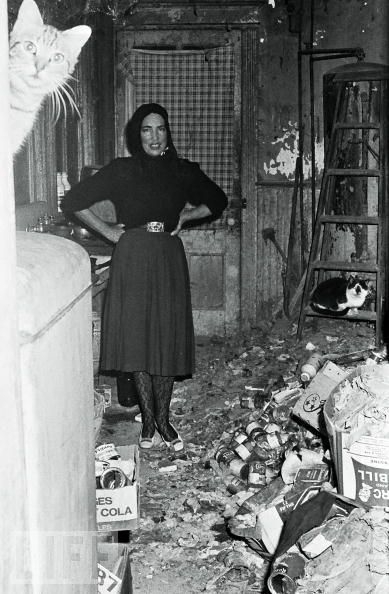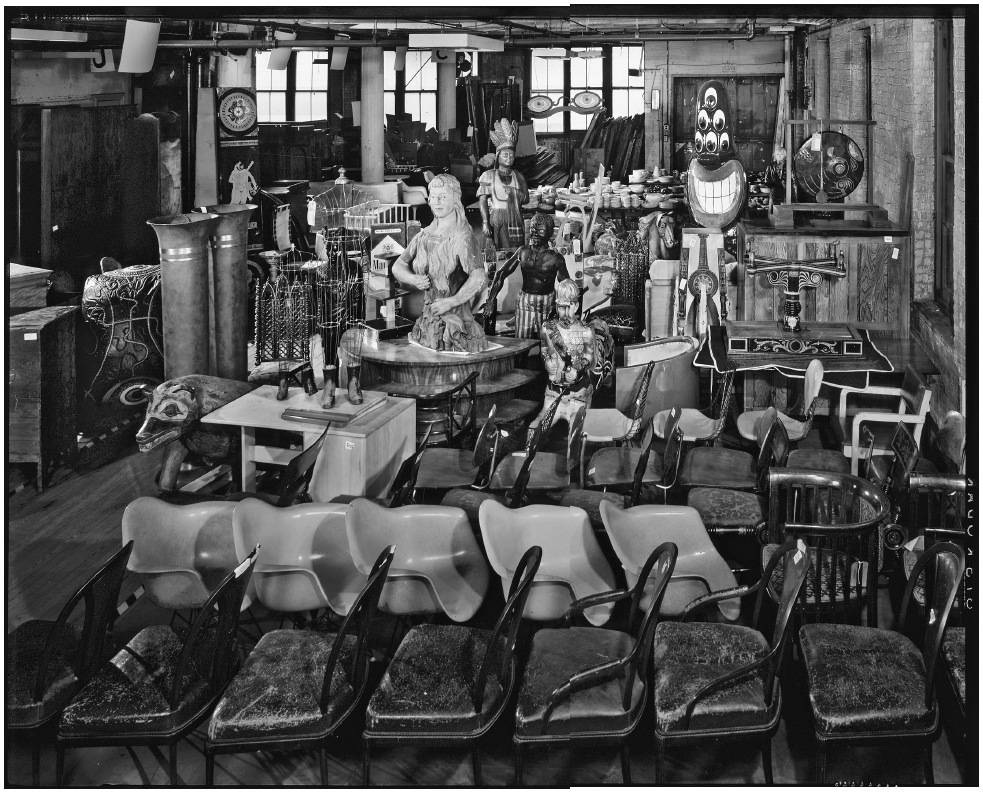The Evolution of Hoarding
Since the twentieth century, both the behaviours and academic conceptions of hoarding have evolved dramatically. This suggests a strong correlation with historical and social factors, which will be the focus of this exhibit. While the majority of academic analyses of hoarding focus on the clinical psychological features of the disorder, they fail to account for its change over time, thereby excluding a broader and more robust understanding of a condition that has only very recently been formally recognized. Scott Herring’s The Hoarders: Material Deviance in Modern American Culture provides a valuable resource for tracing the trajectory of hoarding as both disorder and behaviour, in addition to the framework presented by a Google Ngram search of the word ‘hoarding’ (left).
As seen on the Ngram, 1937 was the peak year for ‘hoarding’ to appear in publications. This is related to monetary conditions in America brought about by the Great Depression. As George Ford Smith writes, “The Great Depression brought hoarding and inflation to center stage.” He observes that “Before 1933, gold coins and banknotes were accepted media of exchange, with the banknotes serving as money substitutes of coins. As long as gold was available to the public, people could protect themselves against bank failures by hoarding gold coins. But if they deposited the gold in banks, it was soon on its way out of town.” Hoarding, in those circumstances, meant exerting personal control over an economic situation that was becoming increasingly overwhelming, and attempting to cling to an older, more stable financial system. This, of course, was detrimental to the banks, and plunged the nation further into peril. As conditions worsened over the course of the Depression and people increasingly lost their confidence in the banks, they started withdrawing their money in large numbers. Recognizing that crisis, in 1932 President Hoover denounced “traitorous hoarding” and organized an antihoarding drive. He also delivered a radio address pleading that people stop hoarding and cease converting bank deposits into cash.
The situation escalated further when Franklin Delano Roosevelt became President in 1933. Smith observes that “President Roosevelt took matters even further. As long as dollars had to be payable in gold coin, the Fed was limited in the amount of money it could create. If the redemption requirement were lifted, the money supply could be determined by government appointed bureaucrats, and government would no longer be held hostage by the promise of convertibility. Getting the public to go along with this coup de grace wouldn’t be easy, but FDR was up to the task.” See the links on the left to Roosevelt’s Executive Order forbidding hoarding in 1933, and a fireside chat he delivered over the radio to the public encouraging them to have faith in American banks.
Also pictured on the left are a number of propaganda posters discouraging hoarding in wartime, in addition to a short video from the 1940s doing the same. ‘Hoarding’ during wartime refers to disobedience of the wartime rationing system, which limited the amount of resources to which each citizen was entitled. Rather than accepting their fair share to ensure equal distribution for both their fellows on the home front and those serving in the Armed Forces, wartime hoarders acquired as much as they could and kept it for themselves. Like Depression-era hoarding, its wartime counterpart was also viciously discouraged through media campaigns in both the United States and Canada.
Herring also observes that the twentieth century marks a dramatic shift in the nature of the hoarding itself, citing that in centuries previous, the term referred primarily to “the accumulation of wealth rather than trash,” and was more commonly associated with the hiding of money. He begins his analysis by reaching far back to history and literarure’s earliest hoarding examples: “Dismayed at ‘tight-fisted clergy,’ Dante Alighieri assigned hoarders to the fourth circle of Hell in his fourteenth-century The Divine Comedy. Citing Shakespeare’s late sixteenth-century play Henry VI, the Oxford English Dictionary defines hoarding ‘in modern use’ as ‘the accumulation and hiding of money.’ Silas Marner, a Victorian protohoarder, stockpiled bags of guineas in George Eliot’s 1861 novel of the same name.” In that way, hoarding was more associated with financial greed, which can also be applied to its Great Depression and wartime cases.
In terms of domestic hoarding, which is more closely related to current understandings of hoarding disorder, the condition was referred to by a variety of names in the decades before its formal designation as a disorder. Herring’s list of early HD synonyms includes Collyer Brothers syndrome, chronic disorganization, pack rat syndrome, messy house syndrome, pathological collecting, clutter addiction, Diogenes syndrome, squalor syndrome, senile recluse syndrome, and syllogomania (stockpiling rubbish). Herring argues that rather than being pathologized, as that nomenclature demonstrates it has been from the outset among scholars, hoarding is better understood as a form of material deviance that reflects “more social apprehension than neurological irregularity.”
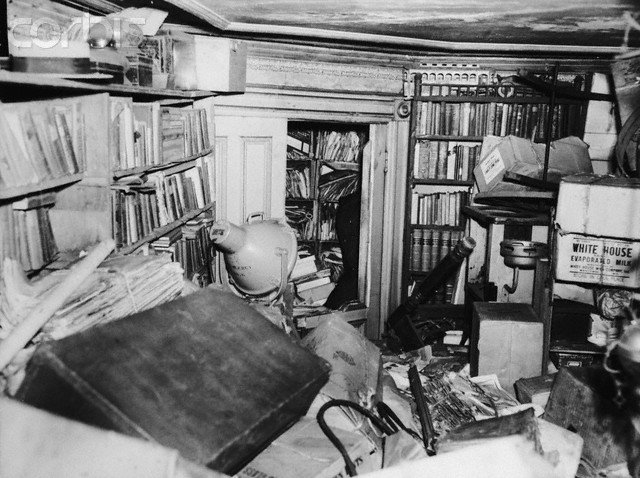

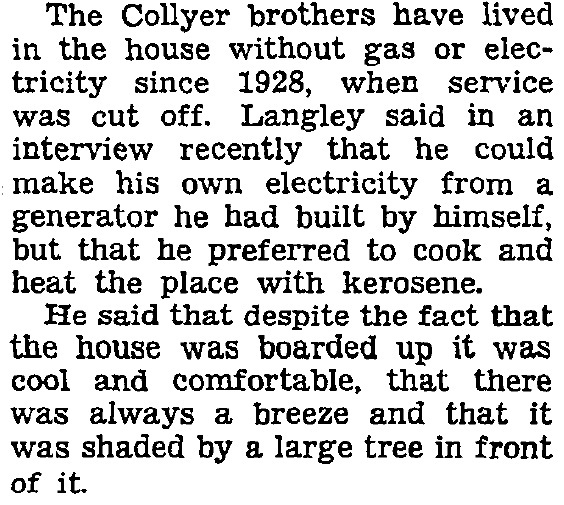
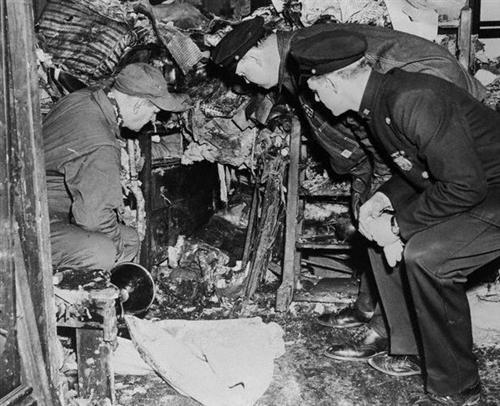
In terms of domestic hoarding, which is more closely related to current understandings of hoarding disorder, the condition was referred to by a variety of names in the decades before its formal designation as a disorder. Herring’s list of early HD synonyms includes Collyer Brothers syndrome, chronic disorganization, pack rat syndrome, messy house syndrome, pathological collecting, clutter addiction, Diogenes syndrome, squalor syndrome, senile recluse syndrome, and syllogomania (stockpiling rubbish). Herring argues that rather than being pathologized, as that nomenclature demonstrates it has been from the outset among scholars, hoarding is better understood as a form of material deviance that reflects “more social apprehension than neurological irregularity.”
Herring argues that the major transition in modern conceptualizations of hoarding came about with the Collyer brothers case in the 1930s and 1940s: “…Representations of the Collyers facilitated a paradigm shift in hoarding as a curious abnormality—a shift that helped make chronic the gradual psychopathy of gross disorganization.” Read about the Collyer brothers story and see excerpts from the media frenzy that surrounded them through the links to the left.
Rather than perpetuate the debates among psychologists as to the brothers’ diagnoses in the decades following their deaths, Herring examines the social factors that played a role in their infamous hoard. In so doing, he describes them as suffering from “Harlemitis,” which relates to the city’s demographic evolution during the time the Collyers called it home. He summarizes:
“Originally a haven for middle-class and upper-class whites such as the Collyer family in the late nineteenth and early twentieth centuries, Harlem witnessed surges of black migration that spiked in the 1920s and continued well into the 1930s and 1940s. Following panicked white countermigrations into the suburbs as a response to the population shift, the neighborhood became a largely black vicinity that many derided as an ‘entropic urban wasteland,’ a slum replete with ‘deteriorating’ houses and ‘immoral bodies.’”
During a summer 1938 interview with Helen Worden (Erskine), Langley Collyer actually denounced his black neighbors: “These terrible children. They called me the spook. They say I drag dead bodies into the house after dark and string them up from our old elm tree. They break my windows. They make my life miserable. They even put a sign on my door saying, ‘This is a ghost house!’… My brother Homer and I were born in E 35th St., on Murray Hill. We came here in 1909. This was a beautiful neighborhood then. We feared Murray Hill was growing commercial. When there was talk of the Tribiro Bridge, Homer bought this house, 2077 [the townhouse across from the one their bodies were found]. We thought that this section would pick up again. Look at it now!... Our ancestors came to America on the Speedwell, which had a better passenger list than the Mayflower.”
Given this profound disassociation from their community and alleged hostility on the part of their neighbours, it becomes easier to fathom the nature of the Collyer brothers’ behaviour. They constructed an elaborate series of booby traps within their hoard, were rarely seen in public, and displayed an intense paranoia. On the outside, the media portrayed them as curiosities, calling them the “Harlem Mystery Men,” the “hermit brothers of Harlem,” “the recluse brothers of Harlem,” and “Harlem’s greatest mystery.” But perhaps the most significant element of their curiosity was the way in which they represented the last vestiges of the original Harlem population, an island of the old city within a sea of perceived decline and massive racial restructuring. Their home thus represents the brothers’ determined efforts to protect themselves and their heritage from the threat of exterior change.
Herring returns to the idea of earlier conceptions of hoarding as an indicator of financial affluence when discussing media speculation about the contents of the brothers’ hoard. He observes a tension between their “simultaneous elite whiteness and curious revulsion,” citing newspaper reports that the brothers “were wealthy beyond the dreams of a Croesus [a king of Lydia,” that they owned “half of [the] waterfront,” and that they “had secreted a hoard of money” ever since they moved to Harlem in 1909. Those speculations were joined by those of the brothers’ “fantastic things, a material opulence thought to best their outstanding personal savings” through local newspaper headlines such as “Neighbors Say Old House Has Grand Piano in Each Room.” One journalist even suggested that “others said he would find, behind the outward appearance of filth and squalor, a veritable Arabian Nights of Chinese rugs, cut-glass rarities in an antique China closets, thousands of morocco-bound books, and more than one grand piano.”
However, the reality discovered after the brothers’ corpses were discovered immediately displaced those notions with a “fascination and revulsion” at the items being removed from the home. Herring reflects on the reactions of onlookers: “As these congregations grew in number and as newspapers encouraged their reactions, the Collyers’ things shifted status from rarities hoarded in a mansion to trash packed into a decrepit old house,” and quotes one newspaper that reported: “The interior of the house was an incredibly dirty mass of debris, old newspapers, cartons, broken furniture and all sorts of junk that Langley had lugged in.” The Collyer case thus marked a shift in conceptions of hoarding from a pastime of the wealthy to a curious and disgusting eccentrism.
On October 22, 1971, the Suffolk County Health Department raided Grey Gardens, an East Hampton, New York mansion occupied by Edith Euring Bouvier Beale and her daughter, Edith Bouvier Beale since 1952. The women were close relatives of former First Lady Jacqueline Lee Bouvier Kennedy Onassis, which resulted in a similar frenzy of media attention to that of the Collyer story. The department documented “a surplus of cats, evidence of semidomesticated racoons, ‘a five-foot high mound of empty cans,’ furniture in tatters, and two impoverished white women.” Magazines and newspapers quickly spread the word that the seventy-six year-old “recluse mother” and her fifty-three year-old daughter faced possible eviction and began releasing sensational photos of the two women and their home. In summer 1972, Jacqueline and her husband Aristotle paid for an extensive cleanup, and three years later the Beales’ story was the subject of the documentary Grey Gardens by director Albert and David Marysles. The Grey Gardens story represents one of the most significant cases since the Collyers' involving the hoarding of debris and worthless items rather than money or valuables.
On October 22, 1971, the Suffolk County Health Department raided Grey Gardens, an East Hampton, New York mansion occupied by Edith Euring Bouvier Beale and her daughter, Edith Bouvier Beale since 1952. The women were close relatives of former First Lady Jacqueline Lee Bouvier Kennedy Onassis, which resulted in a similar frenzy of media attention to that of the Collyer story. The department documented “a surplus of cats, evidence of semidomesticated racoons, ‘a five-foot high mound of empty cans,’ furniture in tatters, and two impoverished white women.” Magazines and newspapers quickly spread the word that the seventy-six year-old “recluse mother” and her fifty-three year-old daughter faced possible eviction and began releasing sensational photos of the two women and their home. In summer 1972, Jacqueline and her husband Aristotle paid for an extensive cleanup, and three years later the Beales’ story was the subject of the documentary Grey Gardens by director Albert and David Marysles.
A third historical hoard cited by Herring involves a slightly different array of hoarded items but nonetheless signals a transformation in the nature of hoarding. In the spring of 1988, the ten-day estate sale of artist Andy Warhol’s possessions following his death revealed the extent of his massive collection: “An observer for Newsweek derided the event as ‘the biggest garage sale ever’ and experienced shock at Warhol’s vast jumble of objets d’art, particularly the ‘lower-priced collectibles.’ Jewelry, she proclaimed with dismay, ‘was found in cookie tins; a Picasso was stuck in a closet. Another closet was stuffed to the top with stunning Navajo blankets,’ and all of it added up to telltale signs of ‘Warhol’s collecting mania.’”
According to Herring, the Warhol case “encapsulates anxieties that underpin discussions of his hoarding in the late 1980s as well as those found in numerous accounts of this psychopathy to this day.” Less than two years after the late artist’s auction, psychiatrist David Greenberg and two of his colleagues published “Hoarding as a Psychiatric Symptom” in the official journal of the American Society of Psychopharmacology, which was an overview of hoarding as it was understood at that time. Herring describes the article as beginning “with an extended survey of ‘normal collecting,’ a wholesome activity that ‘involved the collectors in a social world of dealers, artists, historians, art lovers, and other collectors,’” which they juxtaposed with the hoarders’ “pathological behaviour’ whereby “neurotic patients are unable to part with a variety of useless and valueless objects.”
Psychologists’ attempts at pathologizing hoarding continued from there, with numerous theories and speculations including the disorder being related to an abnormality in the fourteenth chromosome and being a variant of Obsessive-Compulsive Disorder. In 2013, “hoarding disorder” was included in the American Psychiatric Association’s DSM-V, which legitimized the condition as a psychiatric disease under Obsessive-Compulsive and Related Disorders. Because so many symptoms of HD under this designation can also apply to other disorders, it is difficult to determine the percentage of the population who suffers from HD. Based on the limited data, Herring speculates that “…As many hoarders may exist in America as citizens in Vermont, New Hampshire, Connecticut, Rhode Island, West Virginia, Maine, Kentucky, and Montana combined.”

